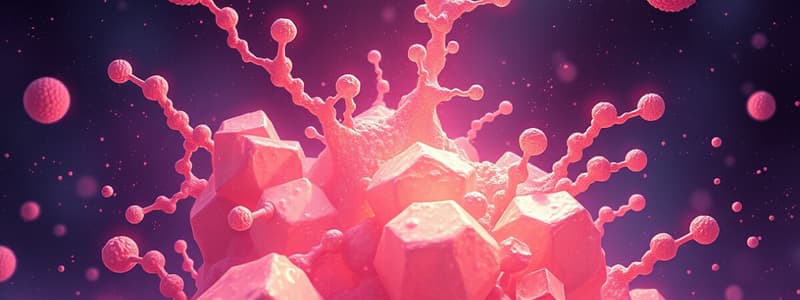Podcast
Questions and Answers
Which amino acid is classified as nutritionally semi-essential?
Which amino acid is classified as nutritionally semi-essential?
- Arginine (correct)
- Histidine
- Phenylalanine
- Leucine
What is the primary factor that stabilizes the tertiary structure of a protein?
What is the primary factor that stabilizes the tertiary structure of a protein?
- Covalent bonds
- Hydrophobic interactions (correct)
- Carbohydrate interactions
- Peptide bonds
Which of the following amino acids cannot be synthesized in the body and must be obtained through diet?
Which of the following amino acids cannot be synthesized in the body and must be obtained through diet?
- Tryptophan (correct)
- Tyrosine
- Cystine
- Arginine
What does the acronym 'PVT TIM HALL' help to remember?
What does the acronym 'PVT TIM HALL' help to remember?
Which statement best defines the quaternary structure of a protein?
Which statement best defines the quaternary structure of a protein?
What are the characteristics of monosaccharides?
What are the characteristics of monosaccharides?
Which of the following statements about isomers is true?
Which of the following statements about isomers is true?
How is the configuration of D- and L- sugars determined?
How is the configuration of D- and L- sugars determined?
Which type of polysaccharide has both α-1,4 and α-1,6 glycosidic bonds?
Which type of polysaccharide has both α-1,4 and α-1,6 glycosidic bonds?
What is the primary dietary role of cellulose?
What is the primary dietary role of cellulose?
Which statement correctly describes polysaccharides?
Which statement correctly describes polysaccharides?
Which of the following is NOT a type of polysaccharide?
Which of the following is NOT a type of polysaccharide?
What is a characteristic of inulin in the body?
What is a characteristic of inulin in the body?
What is the main structural feature that distinguishes amylose from amylopectin?
What is the main structural feature that distinguishes amylose from amylopectin?
Which type of polysaccharide contains only one type of sugar unit?
Which type of polysaccharide contains only one type of sugar unit?
In which structure does the anomeric carbon's hydroxyl group position depend on the form being alpha or beta?
In which structure does the anomeric carbon's hydroxyl group position depend on the form being alpha or beta?
Which of the following statements about glycogen is true?
Which of the following statements about glycogen is true?
What characterizes heteropolysaccharides?
What characterizes heteropolysaccharides?
Which term describes molecules that are mirror images of each other?
Which term describes molecules that are mirror images of each other?
What is the expected structure of monosaccharides with five or more carbon atoms in aqueous solutions?
What is the expected structure of monosaccharides with five or more carbon atoms in aqueous solutions?
What type of bond is primarily found in the structure of amylose?
What type of bond is primarily found in the structure of amylose?
How are epimers defined in carbohydrate chemistry?
How are epimers defined in carbohydrate chemistry?
Which of the following is an example of a heteropolysaccharide?
Which of the following is an example of a heteropolysaccharide?
Which function of proteins is primarily associated with hemoglobin?
Which function of proteins is primarily associated with hemoglobin?
What is the simplest amino acid, which also plays a role in the first step of heme synthesis?
What is the simplest amino acid, which also plays a role in the first step of heme synthesis?
What type of protein is primarily involved in the transmission of nerve impulses?
What type of protein is primarily involved in the transmission of nerve impulses?
Which amino acid is involved in the transamination of pyruvate?
Which amino acid is involved in the transamination of pyruvate?
What major role do glycoproteins serve in cellular structures?
What major role do glycoproteins serve in cellular structures?
Which proteins provide mechanical support in connective tissues?
Which proteins provide mechanical support in connective tissues?
What is the primary function of gamma globulins?
What is the primary function of gamma globulins?
In the context of protein functions, which statement about enzymes is correct?
In the context of protein functions, which statement about enzymes is correct?
What defines the proteome of a cell?
What defines the proteome of a cell?
Which of the following functions is NOT typically associated with proteins?
Which of the following functions is NOT typically associated with proteins?
What is the primary focus of proteomics?
What is the primary focus of proteomics?
Which of the following amino acids is not classified as nutritionally essential?
Which of the following amino acids is not classified as nutritionally essential?
What condition is associated with the accumulation of branched-chain amino acids?
What condition is associated with the accumulation of branched-chain amino acids?
Which amino acid has the largest side chain and is a precursor for serotonin?
Which amino acid has the largest side chain and is a precursor for serotonin?
What is the term for amino acids that must be present in the human diet?
What is the term for amino acids that must be present in the human diet?
Which amino acid is linked to N-linked glycosylation of proteins?
Which amino acid is linked to N-linked glycosylation of proteins?
Which amino acid is converted to ammonia by glutaminase?
Which amino acid is converted to ammonia by glutaminase?
What are the primary products of amino acid interconversion by tissue aminotransferases?
What are the primary products of amino acid interconversion by tissue aminotransferases?
Which amino acid is crucial for the development of phenylketonuria?
Which amino acid is crucial for the development of phenylketonuria?
What distinguishes essential amino acids from non-essential amino acids?
What distinguishes essential amino acids from non-essential amino acids?
Flashcards are hidden until you start studying
Study Notes
Polysaccharides and Monosaccharides
- Polysaccharides are carbohydrate polymers composed of over ten monosaccharide units.
- Monosaccharides are the simplest form of carbohydrates and cannot be hydrolyzed further.
- Sugar units are connected via glycosidic bonds.
- Monosaccharides are classified as ketoses or aldoses and based on the number of carbon atoms present.
- Examples include glucose (aldehyde) and galactose (different –OH at C4) as well as glucose and mannose (different –OH at C2).
Isomerism in Monosaccharides
- D- and L- isomerism pertains to the spatial orientation of monosaccharides.
- Enantiomers are mirror images of each other, distinguished as D-sugars (dextrorotatory) and L-sugars (levorotatory).
- Anomers differ at the anomeric carbon, with alpha (α) having the -OH below the ring and beta (β) above.
Types of Polysaccharides
- Homopolysaccharides (homoglycans) contain one type of sugar unit, e.g. starch, glycogen, cellulose, and inulin.
- Heteropolysaccharides (heteroglycans) consist of multiple types of sugar units, e.g. heparin, hyaluronic acid, and chondroitin sulfate.
- Amylose is about 20% of starch; it has a linear structure linked by α-1,4 bonds.
- Amylopectin (>80% of starch) consists of branched chains with both α-1,4 and α-1,6 bonds.
- Glycogen exhibits even greater branching with α-1,4 and α-1,6 bonds occurring every 8 to 12 residues.
Amino Acids and Proteins
- Proteins are linear polymers of amino acids with diverse functions, such as enzyme catalysis, transport, mechanical support, and immune protection.
- Only 20 amino acids are commonly found in mammalian proteins; 8 are essential (cannot be synthesized) and termed “nutritionally essential.”
- Non-essential amino acids are synthesized in the body but are still metabolically crucial.
Structure of Amino Acids and Proteins
- Amino acids consist of a central carbon, amino group, carboxylic acid group, hydrogen atom, and side chain (R group).
- Essential amino acids include phenylalanine, valine, leucine, isoleucine, threonine, methionine, histidine, tryptophan, and lysine.
- Arginine is semi-essential, synthesized from dietary sources but also produced in the body.
- Tertiary structure is the overall 3D shape of proteins, stabilized by various bonds (disulfide, hydrophobic interactions, hydrogen bonds, ionic bonds).
- Quaternary structure refers to the assembly of multiple polypeptide chains into functional units.
Additional Concepts
- Glycine is the simplest amino acid and plays a role in heme synthesis and neurotransmission.
- Alanine acts as a carrier of ammonia and carbon from muscle to liver and is involved in transamination reactions.
- Branched-chain amino acids (valine, leucine, isoleucine) are essential and interconvertible via tissue aminotransferases.
- Phenylalanine is a precursor to tyrosine and accumulates in phenylketonuria.
Studying That Suits You
Use AI to generate personalized quizzes and flashcards to suit your learning preferences.




